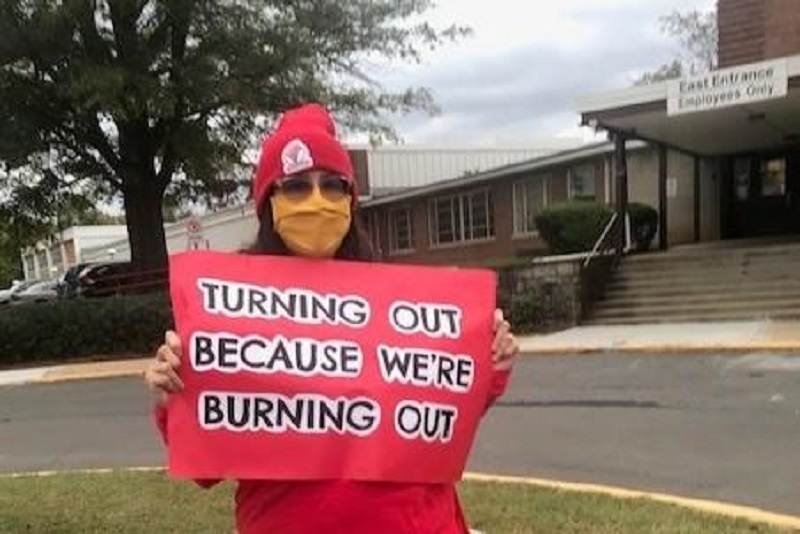There’s no shortage of teachers. We’ve just driven them out of schools.

A Montgomery County, Maryland, middle school teacher holds a sign during a rally to protest staff shortages in October 2021.
14:20 JST, August 9, 2022
There’s no teacher shortage.
Sure, schools across the country are grappling with a vacancy rate so high that they’re cutting the school week down to four days, loosening certification standards and even hiring veterans who have never taught.
But it’s not a shortage of teachers that’s causing this nationwide crisis.
The teachers are out there. They’ve just had enough of the real shortage that is decaying their profession: respect, value, common sense and safety.
“I think people needed someone to be angry at,” said Maggie McCabe, a Stafford County, Virginia, English teacher who was one of thousands of teachers across the country who quit this year when their dream job became toxic.
“Teachers became Public Enemy No. 1,” McCabe told the Culpeper Star Exponent. “I had to delete so many friends [on social media] because I couldn’t get up and do my job the next day because of how we were being talked to.”
It happened across the nation.
“I was a teacher for 21 years and I retired last year,” Charla Detjens, who was stunned at how toxic her ordinarily supportive small town on the West Coast became toward teachers, said when we chatted online. “I will go work retail or something rather than go back into the classroom after the vitriol from the community about teachers and covid.”
We used to ask teachers only to work long hours, discipline the children parents failed to parent, coach a team, head a committee, run the bake sale and carve pieces off a meager salary to buy school supplies.
In the past two years, America also has suggested they carry guns to protect kids, risk their health to go into classrooms of unmasked children at the height of the pandemic, endure preposterous culture wars over curriculum that question their experience and education, all while withstanding shrill and unfounded accusations of “grooming” children for sexual purposes.
Between the pandemic, school shootings, the politicizing of curriculum and bonkers narratives, this may be the worst time to be a teacher in America since the 1800s. (That’s when teachers like Olive Mann Isbell – niece of education reformer and abolitionist Horace Mann – taught pioneer children in California with “a gun that swung from the belt of her gingham dress” and were often paid in preserves and eggs.)
That was the American frontier, where women took on the hardship because it was a chance to find work, according to “Frontier Teachers: Stories of Heroic Women of the Old West,” a book by Chris Enss.
They helped change the profession from largely male – in its American infancy on the East Coast – to predominantly female. And with that change came the devaluation of one of society’s most crucial callings.
“As the gender ratios of teachers changed, so did the pay and the social prestige associated with teaching,” Elizabeth Boyle wrote in an essay for the Women and Gender Studies Program at MIT in 2004.
The underpaid teacher became an accepted part of the American social rubric, spawning a popular bumper sticker that read: “It will be a great day when our schools get all the money they need and the Air Force has to hold a bake sale to buy a bomber.”
A society that pays corporate lawyers right out of law school nearly four times what it pays a schoolteacher with 15 years experience is clear about its priorities.
But that’s not what is pushing this crisis in our nation today. In fact, while American teachers are still underpaid in my eyes (this always becomes clear to any parent after a volunteer day in class or on a field trip), they are toward the top of global earnings for primary school educators.
The average pay for a U.S. high school teacher with 15 years experience is about $65,000 a year, according to the Organization for Economic Co-operation and Development’s global data for 2020. That puts us seventh in the world, behind teacher’s paradise Luxembourg ($109,000), Germany ($91,000) and others. At the bottom of the OECD’s list of 33 nations is Slovakia ($19,000).
Compensation was among the reasons American Federation of Teachers members said they were dissatisfied with their jobs, according to the union’s June survey. Seventy-five percent of the teachers surveyed said their jobs changed for the worse, with 29% of them saying that was due to pay.
But the number of teachers who reported at least some level of dissatisfaction with their jobs rose 33 points since 2020, “two years marked by relentless political attacks, persistent shortages, school shootings and flatlining salaries,” according to the union.
“AFT members were on the frontlines of the first wave of the pandemic, but in many ways the last year was even harder,” AFT President Randi Weingarten said in a statement about the survey. “Whether it was mask wars, culture wars, the war on truth, or the devastation in Uvalde, members sacrificed and struggled and carried their schools and their students through the most difficult days of their lives.”
On top of all that, federal data showed that 80% of schools reported increases in student behavioral issues, including rowdiness, threats and fighting between students and aggression toward teachers.
Kids who spent a year or more going to virtual class in their PJs are not adjusting well to being back in a classroom. It’s been hard on them and many are acting out in class. Add misdirected, parental freakouts about critical race theory and sexual orientation, and too many kids have been groomed at home to mimic that jackassery in the classroom.
Who would want to work like this?
The crisis isn’t the lack of teachers. It’s the nationwide disrespect for those in the profession.





